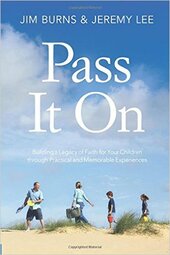When I was in grad school, author and professor, Steve Gerali, taught me about how important rites of passage are in the faith formation of young people. Since then, I've been a big fan of including these experiences in my youth ministry. I'm also blessed to be at a congregation that regularly uses rites of passage in the faith formation of our children. Now, as a new parent, I'm intrigued at the possibility of utilizing rites of passage with my own daughter.
For those reasons, I was excited to read Jim Burns' and Jeremy Lee's Pass It On: Building a Legacy of Faith for Your Children through Practical and Memorable Experiences.

The first three chapters of this book detail the importance of rites of passage in the faith formation of children and teens. According to Jim and Jeremy, rites of passage work because “Symbols have power and they are a special way to help children understand abstract concepts of faith & spirituality.” Knowing this, rites of passage become “reminders that His story is also a part of your family's story.” Recognizing the intentionality required for rites of passage experiences, Jim and Jeremy challenge parents with this question, “What would happen if you applied the same commitment, preparation, and discipline to your children's spiritual growth as you do to their education or athletic development?”
After establishing the framework for rites of passage, Jim and Jeremy offer a series of rites of passage for children each year, kindergarten through twelfth grade. While many congregations utilize rites of passage in their faith formation strategy, the beauty of Jim and Jeremy's book is that the rites of passage they've designed are meant to be done at home, within the context of a family.
Each of the chapters on a specific rite of passage is divided into several parts: An exploration of the rite of passage itself, Scripture passages that will help parents lay the foundation of faith as it relates to that specific rite of passage, and information about a child's physical, emotional, relational, and spiritual development at that specific point in time. Each chapter also contains a compelling story about how a particular rite of passage impacted a family told by someone who actually utilized it.
My favorite chapters in Pass It On are the ones that use rites of passage to address ordinary concepts. For example, the third grade rite of passage is “An invitation to Rhythm” that centers on helping kids make “good decisions about rhythms of life, rest, priorities, and stewardship of time”. From my work as a youth pastor, I know how important (and needed!) this is in most people's lives, yet it never would have occurred to me to develop a rite of passage around this.
The one criticism I have of Pass It On is the order in which each chapter is subdivided. Pass It On would have read better if the rites of passage chapters each began with the information about a child's physical, emotional, relational, and spiritual development rather than ended with it. Doing so would have enabled readers to better understand how each rite of passage is uniquely connected to that stage of a child's developmental journey.
Despite this, in Pass It On, Jim and Jeremy have created an incredible resource for parents and youth workers. As a parent, Pass It On is a book I will refer to often in the upcoming years as I enact many of these rites of passage with my daughter. As a youth worker, not only is this a book that I will gladly place in the hands of other parents, but it's also one that will help me to continue to think creatively about how to include additional rites of passage into our ministry with children and teens.
*****************************************************
Disclosure: I received a free copy of Pass It On in exchange for a fair and honest review.